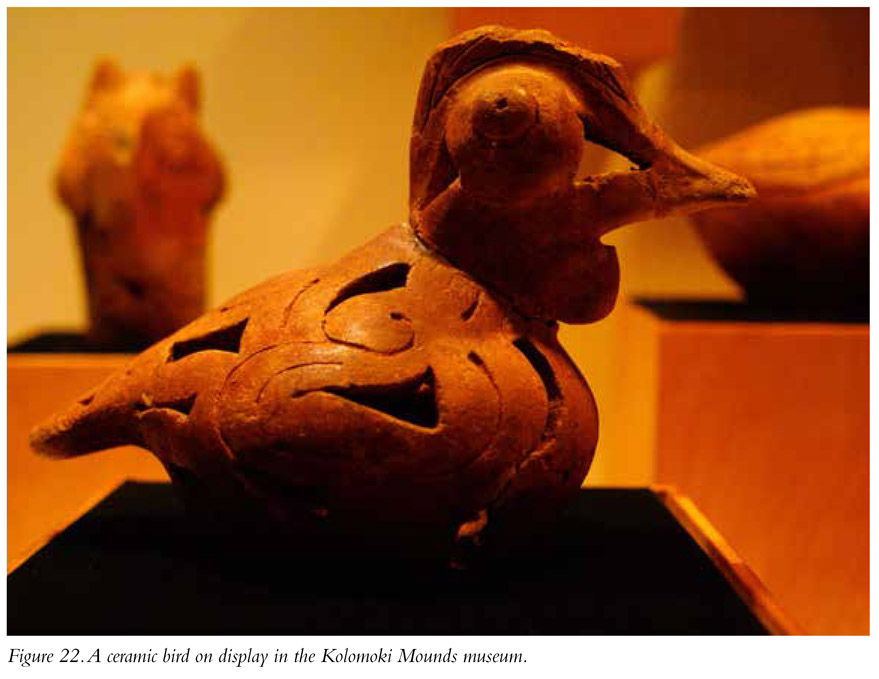
Blakely, Georgia
Journal Entry
August 15, 2008
Have you seen the bumper sticker “Mean People Suck”? As a general statement, I think we can all agree with that sentiment: Mean people really do suck. I include under that label folks who would break into a lovely little museum dedicated to memorializing the history of the native peoples of southwestern Georgia and then steal not just individual artifacts but also the opportunity for visitors to see, appreciate, and learn from those wonderful works of art and craft. This is exactly what occurred at Kolomoki Mounds State Park in 1974. Thieves broke into the on-site museum and absconded with 129 artifacts that had been excavated at the site. Artifacts are like books, especially in the case of a non-literate people who left behind no written account of their lives. Archaeologists can read tools, as well as works of art, and convey the stories these objects tell us in the here and now. The good news is that fifty-nine of those artifacts, those stories told by past people, have been recovered. The bad news is that seventy of them remain missing. That’s seventy stories that may never be told again.
What You Will See
Kolomoki is a relatively small, but nevertheless impressive, mound site located in southwest Georgia. Two large mounds sit on either end of a broad plaza. The large platform mound is monumental and impressive, a 57-foot-high truncated pyramid with a rectangular footprint of 325 by 200 feet (Figure 21). To pile up enough earth to produce this mound, the makers would have needed to dig up, fill, carry, and pile up about 11 million one-gallon buckets of soil, a truly monumental undertaking. The other large earthwork is a pretty large conical mound. Six more smaller earthworks demarcate a small plaza. It’s a very short, pleasant hike across the plaza from the main platform mound to the largest of the site’s conical mounds. There’s also a very nice museum on-site, built directly over and within the remains of a burial mound. So when you walk to the back of the museum, you’re actually walking into the bowels of the burial chamber within the mound (weird!). Many of the burials have been left more or less as they were found, except that the skeletons are replicas. There are also some beautifully made ceramic vessels on display in the museum (Figure 22).


The site is situated within a state park with hiking, swimming, camping, fishing, boating, picnicking, and even minigolf. (I wonder what archaeologists in the future will make of minigolf courses.)
Why Is Kolomoki Important?
While Kolomoki isn’t the largest or most impressive of the mound builder sites visited in our odyssey, it is nevertheless important, at least in part because it is one of the oldest. Radiocarbon dating shows that the site was occupied as early as AD 250, and the mounds were all built before its abandonment by AD 950. In other words, Kolomoki was already a ghost town by the time most of the other mound sites we’re visiting in the Southeast were only getting started.
Kolomoki was a large community whose peak population exceeded 1,000, yet another example of a densely settled mound builder community in the American Southeast.
Site Type: Platform Mound, Burial Mound
Wow Factor: ** The largest of the Kolomoki Mounds is impressive.
Museum: The museum is built into and around a burial mound. When you walk into the museum, you are walking into the interior of the mound.
Ease of Road Access: *****
Ease of Hike: *****
Natural Beauty of Surroundings: ***
Kid Friendly: **
Food: Bring your own.
How to Get There: Kolomoki is located in southwest Georgia, in Kolomoki Mounds Historic Park; near Albany and 6 miles north of Blakely off US 27. Punch 205 Indian Mounds Rd., Blakely, Georgia, into your GPS.
Hours of Operation: Grounds open daily 7 a.m. to 10 p.m. Museum open daily 8 a.m. to 5 p.m.; closed on major holidays.
Cost: See website.
Best Season to Visit: It certainly is hot and humid here in summer, but since there’s no long hike to take, a visit just about any time is fine.
Website: http://gastateparks.org/KolomokiMounds
Designation: State park; National Historic Landmark